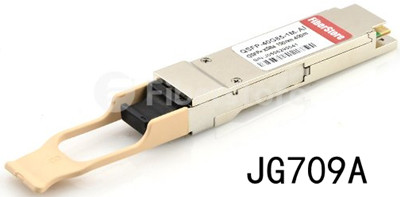Nowadays, data centers are witnessing a rise in the number of network connections, and it’s necessary for data centers to achieve even higher-density in both ports and cabling to accommodate the bandwidth demands. Parallel optics combining the use of cables and fiber optics serve as the medium to satisfy the growing need for transmission speed and data volume.
Multi-fiber connectors bring together 12 or 24 fibers in a single interface just as compact as a RJ45 connector. The multi-fiber push-on or also multi-path push-on (MPO) technology and especially the MTP connectors from the manufacturer US Conec have proven themselves as a practical solution for high-performance data networks in data centers. This paper mainly introduces MPO/MTP technology, and parallel optics which utilizes this multi-mode connectors in 40 Gigabit Ethernet (GbE) transmission.
Before going into the main body, a table showing the 40GbE standard, cable types and maximum allowable distances is below.
| Transmission technology | Cable type | Signal Rate | Maximum distance |
| 40GBASE-KR4 | PCB (bus) | 4 x 10 Gb/s | 1 m |
| 40GBASE-CR4 | Copper, Twinax | 4 x 10 Gb/s | 7 m |
| 40GBASE-SR4 | OM3, OM4 | 4 x 10 Gb/s | OM3 100m, OM4 150m |
| 40GBASE-LR4 | Single-mode Fiber | 4 x 10 Gb/s | 10 km |
As is shown in the table, while establishing 40GbE links, parallel optical channels with multi-mode fiber (MMFs) of the categories OM3 and OM4 are used. The ports have to accommodate four or even ten times the number of connectors. This large number of connectors can no longer be covered with conventional individual connectors, which explain the reason why the 802.3ba standard incorporated the MPO multi-fiber connector for 40GBASE-SR4 and 100GBASE-SR10. It can contact 12 or 24 fibers while saving space.
IEC 61754-7 and TIA/EIA 604-5 defined MPO connector that can accommodate up to 72 fibers in the tiniest of spaces, most commonly used for 12 or 24 fibers. This MPO connector is designed for the high-density connection of MMFs, allowing easy connection and disconnection. MPO connector has two alignment pins to align the ferrule, and a clamp spring. When closed, the MT connector is extremely compact and is thus well suited for high-density fiber connection within closures or cabinets. The kind of multi-mode connector combines high-density connection with convenient disconnecting action, ideal in satisfying the need for high-density packaging in equipment. In 40G links, QSFP+ transceivers use MPO connectors as the interface for high performance. Just like, this HP JG709A 40GBASE-CSR4 QSFP+ transceiver listed on FS.COM achieves 300m link length with MPO connector.

Category OM3 and OM4 MMF are the future-proof cabling choices for 40G links. Lasers are used for OM3 and OM4. These lasers are generally vertical-cavity surface-emitting lasers (VCSELs) which are cheaper than distributed feedback lasers. The VCSELs are able to transmit data at higher rates. According to the table shown above, OM3 has a link length of 100 meters so it supports about 85 percent of all data center channels depending on architecture and size, and OM4 fibers have a link length of 150 meters so they cover nearly 100 percent of the required reach.
As noted in the table, the 802.3ba standard defines the parallel operation of four OM3/OM4 fibers for 40GbE in 40GBASE-SR4. Two fibers have to be used per link because this arrangement is full duplex operation, i.e. Simultaneous transmission in both directions. Therefore the number of fibers increases to eight for 40GBASE-SR4. That is four of the twelve fibers remain unused and eight of the twelve fibers are used in each case in connection with 12-fiber and MPO connectors. In the parallel optical link, the signal is split, transmitted over separate fibers and then joined again. That means the individual signals have to arrive at the receiver at the same time.
MPO/MTP technology is performance- and quality-assured as a trend for decision makers in to carefully plan their fiber optics infrastructure for 40GbE transmission. FS.COM provides not only high-quality MPOMTP connectors, but also MPO-based patch cables (eg. Push-Pull MPO cable). You can visit FS.COM for more information about MPO connectors and MPO-based cables.

